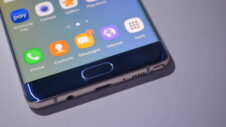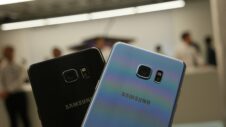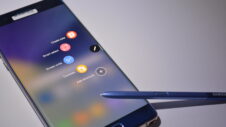Samsung has brought back microSD card storage in the Galaxy S7 and Galaxy S7 edge, having made the feature cooperate with the company's faster flash memory (UFS 2.0) that made its first appearance in the Galaxy Note 5. Around the time of the official announcement, it was believed that the pre-installed Marshmallow sweetness would bring Adoptable Storage, an implementation that lets you insert a microSD card and use it for additional internal storage. In other words, in the same way that you can save all apps, photos, screenshots, downloads, and even Twitter images (for example) to your device's internal storage, you'd be able to do the same with adoptable storage. Adoptable storage would treat your microSD card as additional internal storage and would work in the same way as native storage.
Samsung made a decision not to introduce Adoptable Storage into the Galaxy S7 and Galaxy S7 edge because the company's consumer research indicates its consumer base wants the freedom to transport microSD cards from its phones to other portable devices, a freedom that would be impossible with Adoptable Storage.
And yet, I want Adoptable Storage. I understand that my view here disagrees with Samsung's consumer research, but I want Adoptable Storage in the Galaxy Note 7. Not only do I want it; I also think there are some excellent reasons why Samsung should go with Adoptable Storage in the upcoming “Galaxy.” Here are my two reasons.
Reason #1: MicroSD card storage doesn't let you save all apps to the SD card
My Galaxy S7 edge has a 128GB Samsung microSD card (I wouldn't buy one from any other manufacturer if I were you), and I've recently taken time to reconsider what many consumers see in microSD card storage as such a good thing. I had my issues with microSD card storage back in the Galaxy S5, and, two years later, this first reason still rings true. Though we've gotten faster cameras, higher-resolution displays, faster flash storage, more premium build quality, and better-performing batteries, microSD card memory has progressed very, very little.
Even after two years since the Galaxy S5, users still can't save all apps to the microSD card. Yes, you can save some apps to your microSD card, but you have to check the storage of each app to see which ones are transfer-friendly. Consumers praise this feature as a must-have for phones, but why would anyone want microSD card storage when it just creates fragmentation for smartphone performance? Why rave about the “freedom” one has with microSD card storage when having all that “storage freedom” comes with limitation in something as basic as what you can and can't use it for?
After all, if functional features expand capabilities, why is it that “expandable” microSD cards limit app storage? Just because microSD card storage can save media (videos, photos, music, etc.) doesn't mean that we can overlook its limitation and flaws. MicroSD card storage, like native storage, has its flaws, and not everyone views microSD cards as the best storage means.
Adoptable Storage in the Galaxy Note 7 would fix this issue: apps could be saved in the same way with Adoptable Storage that they are saved on the device with native internal storage. MicroSD card storage just isn't smart enough yet, and Adoptable Storage would give us not just microSD storage, but smart microSD storage that would work with, not against, native storage.
Reason #2: MicroSD card storage doesn't know how to merge pre-SD card media and post-SD card media
MicroSD card storage isn't smart enough to let you use its storage for every app possible on your smartphone, but that isn't all: microSD card storage also doesn't know how to merge pre-SD card media and post-SD card media. I'd been using my Galaxy S7 edge without a microSD card for weeks before I purchased and then installed a microSD card. Upon installation, there was a popup message that said that from this installation forward, all camera photos would be saved to the SD card.
And yet, there's a problem here: what about the camera photos stored in native storage? Why is it that, when you place a microSD card into the device, it isn't smart enough to ask you “would you like to move your current camera photos and other media to your SD card?,” with a menu that would let you check the data you want to move over to the new expandable storage?
The same can be said for screenshots: I created an album called “Screenshots” on my SD card, then proceeded to take a screenshot. The result? The Galaxy S7 edge saved it to my native storage and didn't recognize my SD card even lives in the device. So, when I take screenshots from now on, I have to move over the duplicate screenshot folder to the SD card. It's as if native storage doesn't want to be “friends” or even play nicely in the sandbox with microSD storage.
My 200GB of Google Drive storage and my 1.1TB of Microsoft OneDrive storage don’t need me to continue moving camera photos to storage after I select my camera to “automatically save” images to my account. Additionally, cloud storage will backup photos saved to native storage when cloud storage was absent or disabled, not just the photos you took with cloud storage enabled. Cloud storage just seems smarter in that I can select what to save to it once (not every time I need to move something) and it does exactly what I need. Press “camera backup” once, and you need not remember to move over those unboxing photos (or even unboxing screenshots from YouTube videos) once you set the option in place.
The Galaxy Note 7, with Adoptable Storage, would fix the issue by eliminating this fragmentation of current microSD storage that separates your media pre-SD card installation and post-SD card installation. It would perform like native storage and save all photos without a glitch.
Conclusion
Expandable storage is touted as the top feature everyone should want in a phone. Galaxy Note 4 owners will gladly tell you if you're a Note 5 advocate that microSD storage is lacking on the Note 5 and that if a device doesn't have microSD card storage, it's not for them. And yet, when you examine microSD storage with its fortes and flaws, what Note 4 fans love about it becomes less clear.
Adoptable Storage would utilize microSD storage to its full potential. It would allow consumers to have Smart MicroSD storage that would know a screenshot is a screenshot, camera photos are camera photos and not create duplicate files. Like cloud storage, Adoptable Storage in the Galaxy Note 7 would save everything and utilize all of your device storage (not just part of it). Adoptable Storage would not fight against native storage but cooperate with it. A world in which microSD storage is smart would change the game. As good as many think a Galaxy Note 4 was with microSD storage, Adoptable Storage in the Galaxy Note 7 would be and perform better than any microSD storage-endowed Galaxy Note yet.
And the day Samsung ditches microSD cards/storage as they are, and implements them as Adoptable Storage so that I can fully utilize them, I'll see microSD storage as more of a friend and less of an enemy. Unfortunately, as to the greatness of microSD storage, the verdict's still out.







